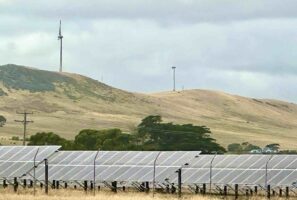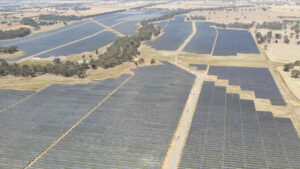The growth in renewable energy, and rooftop solar in particular, helped push spot and forward electricity prices down in the first quarter, but the spectacular failure of one of the country’s biggest coal generator and searing heatwaves caused prices to spike in two of Australia’s most coal dependent grids.
According to the Australian Energy Regulator’s Wholesale Markets Report for the first quarter, average prices fell in NSW (by $6 per megawatt hour) and Tasmania (by $12/MWh) from the same quarter a year ago, and the biggest fall occurred in South Australia ($16/MWh), which averaged 75 per cent wind and solar throughout the three months.
Victoria would have actually shown the biggest fall in wholesale prices were it not for the dramatic events of February 13, when an intense storm tore down transmission lines and the state’s biggest coal generator, the Loy Yang A facility in the Latrobe Valley, tripped.
That single event, which pushed spot prices above $5,000/MWh for just five consecutive 30-minute trading periods and to the market cap of $16,600/MWH for three of them, had an extraordinary impact, adding $23/MWh to the average wholesale price in Victoria for the entire quarter.
That equates to an extra $317 million, just from 2.5 hours of inflated wholesale prices caused primarily by the sudden unexpected loss of the state’s biggest coal generator.
Without that event, Victoria’s average price would have fallen $17/MWh for the quarter, compared to the same period a year ago. As it turned out, the event caused average prices in the state to rise $6/MWh, despite the fact that it was by far the biggest exporter of electricity in the quarter, sending 16 per cent of its production to other states.
Victoria remains heavily dependent on its three remaining brown coal generator, but it had the highest share of wind and solar in the country after South Australia (38.7 per cent of local demand). It has a target of 95 per cent renewables by 2035.
That major storm also had an impact on South Australia, which suffered several high priced trading periods because of the transmission damage that limited the amount of electricity it could import. Without those price spikes, the AER report makes clear, South Australia’s average wholesale price would have fallen $30/MWh in the quarter.
Queensland, which suffered a series of heatwaves and remains the most heavily dependent grid on coal fired generation in the country, suffered the biggest average price spike in the March quarter.
There were 11 30-minute trading periods when prices spiked above $5,000/MWh in Queensland in that quarter. Just those high priced events adding a whopping $30/MWh to the average wholesale price for the quarter, or $552 million.
As it was, Queensland suffered a $23/MWh increase in its average price which means that without those high priced events, average prices would have fallen in the quarter.
Elsewhere in the report, the AER said it was noticeable that there were minimum daily demand records posted in South Australia and Victoria during the quarter, due to the generation by rooftop solar systems on sunny yet mild summer days .
Forward prices for electricity for the 2025 calendar year also fell on average in all regions, with decreases ranging from $1 per MWh in Queensland to $12 per MWh in South Australia.
It said that overall, forward prices for 2024 and 2025 are now well below forward prices seen in 2022, but they are yet to return to historic levels and remain higher than 2020 and 2021.
“It’s encouraging to see forward prices for electricity fall for the next calendar year, however they continue to be sensitive to market conditions,” AER board member Jarrod Ball said in a statement.
Federal energy minister Chris Bowen said that the report underpinned the government’s policies, which seek more renewables – it has an 82 per cent target for 2030 – and its cap on coal prices.
“The AER’s report shows our plan for reliable renewables firmed with storage and gas is working, with renewables driving down prices, and gas available where and when it was needed thanks to our Gas Code of Conduct and directing more gas into storage,” Bowen said in a statement.
The AER report noted that the influx of renewables meant that there was more power offered into the market in the first quarter than any of the quarters last year.
Most of this was offered in at prices below $50MWh, due to downward pressure from cheap renewable generation. It was particularly noticeable that coal generators in Queensland offered significant amounts of capacity at prices below zero because of the impact of rooftop solar.










